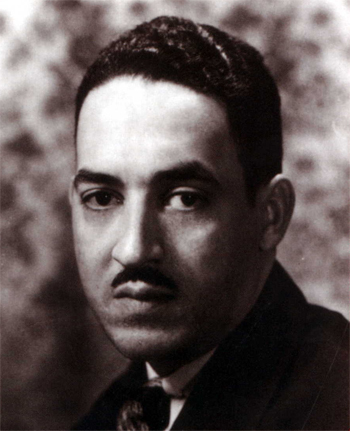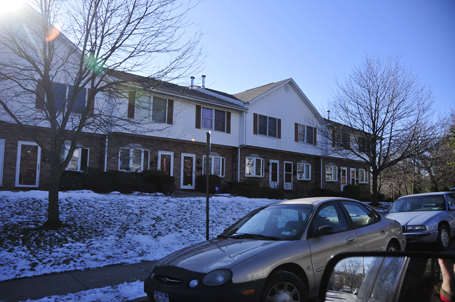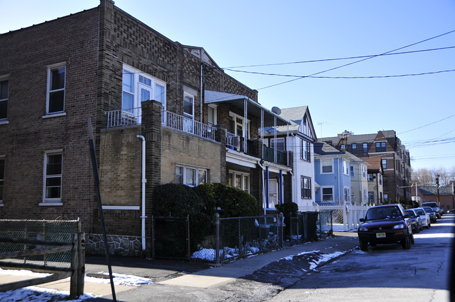
Lincoln School Desegregation Today (Part V): The Trial, Plaintiff's Case
 Thurgood Marshall |
Lincoln School Desegregation Today: Part I - Early Gerrymandering
Lincoln School Desegregation Today: Part II - The Dodson Report
Lincoln School Desegregation Today: Part III - Frustration Grows
Lincoln School Desegregation Today: Part IV - Civil DIsobedience
We continue with Part V...
The data in Part V comes from a report called "Civil Rights USA: Public Schools Cities in the North and West 1962 - New Rochelle by John Kaplan, A Report To the United States Commission on Civil Rights" The report can be found at the Thurgood Marshall Library website at the University of Maryland.
The writing was highly technical at time. This information presented here is an effort to distill the information while retaining the content with a focus on the personalities involved in the case. For those interested in a the technical aspects of the case, we will provide the full report in the coming days.
The Complaint
On October 21st, 1960 Attorney Paul Zuber filed a complaint against the New Rochelle Board of Education on behalf of Hallie Taylor's eight year old daughter Leslie and other children. "The core of Zuber's complaint was an indictment of the neighborhood school. He said that ghettos exist where minority students live and are crowded and segregated. If there is a neighborhood school, it is segregated, too.
The complaint reads:
It has been well recognized that in many cities of New York State, and elsewhere, ghettos exist in which minority groups, usually minority racial groups, are crowded. As a result thereof, the public schools in such neighborhoods in such cities are segregated, reflecting the segregated pattern of the neighborhood.
The utilization of the "neighborhood school" policy in such areas must, of necessity, produce segregated schools. This fact pattern set forth herein also exists in the city of New Rochelle. It exists there by reason of the fact that the defendants continue to maintain the aforesaid 'neighborhood school' policy as a basis for the registration of children required, under the Education Law of the State of New York, to attend the elementary schools. The fact is that so long as the defendants adhere to this 'neighborhood school' policy in the city of New Rochelle, segregated schools will exist there.
The complaint further alleged that "(1) the Lincoln school was 'attended only by Negro children,' (2) the 'educational background and length of experience' of its teachers was inferior to that of teachers in "white" schools, (3) the curriculum offered at Lincoln was inferior to that offered in the 'white' schools, and (4) as a result of the use of the neighborhood school policy—. . . the plaintiff children, and other Negro children attending the racially segregated school, do not achieve at their natural intellectual potential, as the white children attending the all-white school achieve in respect to their natural intellectual potential.
 |
| Residences on Remington Place |
The Judge and the Attorneys
Judge Irving R. Kaufman presided over the case. He was famous for ordering the execution of Ethel and Julius Rosenberg, alleged Communist spies ten years prior.
Attorney for the city of New Rochelle and Board of Education was Murray Fuerst, came to the October 27th hearing and asked the court not to grant a preliminary injunction. Soon after Mr. Fuerst agreed that the construction of the new Lincoln school would not begin until the litigation had been concluded, and that the hearing on the preliminary injunction might be combined with the final trial on the merits, so that only one decision would be necessary. Mr. Zuber and Judge Irving R. Kaufman agreed to this, and the trial was set for November 15.
Eventually Julius Weiss became the lead attorney for New Rochelle. He was a former BOE member in the 1950s and was involved in New Rochelle civic affairs. Weiss asked for a one month delay and Judge Kaufman gave him one week and set the combined trial and hearing for November 22nd. On November 21st Weiss asked Judge Kaufman for three judges instead of just one. His request was denied.
So we have a hearing that may convert into a trial if all parties agree. There is one judge and no jury. The BOE has agreed to hold off on any rebuilding of Lincoln for now to avoid a preliminary injunction which might damage the reputation of New Rochelle. This takes place in New York City. It is November 1961.
The Hearing
Mr. Zuber called his witnesses.
The first witness was Hallie Taylor who spoke about why she wanted her daughter Leslie to go to an integrated school for a better education.
The second witness was William H. Sneed, a school psychologist. He said, John Kaplan paraphrases, "Leslie Taylor scored 136 on her IQ test, but her score would have been even higher had her vocabulary and reading ability not pulled it down (the scores) could reflect a lack of academic stimulation in the school." In cross examination Dr. Sneed conceded that her socioeconomic position may have hindered her academically as well.
The third witness was Bertha Oden White, a housewife and private tutor. She was Mr. Zuber's star witness and spoke about how she had been studying gerrymandering in the Lincoln school district since 1948 and had searched school records back to 1909. She spoke to residents of the neighborhood and explained how the district lines had changed through the years. She also spoke about how Lincoln District's white children were granted variances to attend other elementary schools in New Rochelle. Attorney Weiss did not object to Betha White's testimony, though John Kaplan said that it may have been considered inadmissible and called hearsay, which may or may not have chanegd the outcome of the case.
Transfer Policy prior to 1949
John Kaplan writes "Mrs. White described a study she made in 1948 of the children who lived in the Lincoln area. She found that numerous white children who lived in the Lincoln zone were attending other elementary schools while all the Negro residents were attending Lincoln." She implied transfers were denied to black children. John Kaplan writes "There are documented cases of Negro residents of the Lincoln area who before 1949 asked that their children be permitted to transfer to other schools but were denied transfer by the Lincoln principal because they "lived in the Lincoln district." There is no record of a white pupil's has been denied transfer during this time."
Regarding the transfer policy, John Kaplan describes "testimony toward the end of the trial of Sim Joe Smith, the assistant superintendent of schools. Mr. Smith, before the rigid transfer policy was instituted in 1949, had been in charge of approving all transfers, and he clearly knew more than anyone else what the facts were. Unfortunately, his testimony was so unhelpful in this regard that it gave rise to charges of evasion by the judge. Mr. Smith testified that he had jurisdiction over all transfers, but that he had absolutely no idea how many of the students transferring were Negro and how many were white since he did not classify people by race. Even had Mr. Smith been completely straightforward in all of his other answers (and areading of the transcript makes it clear that he was not), he would have had great difficulty getting anyone in New Rochelle to believe that he pays no attention to race."
 |
| Residences on Remington Place |
Mr. Zuber's next witness, after Bertha White, was Nolan Fallahay, a professior of English at Iona College and member of the school board. He had been one of the board members who spoke against rebuilding the Lincoln school. He said that since he was on the board in 1955 several opportunities came for the school district to act upon the segregation at Lincoln, but the board chose not to act.
The next witness was Marylyn Pierce, the only Negro member of the board of education. She spoke about how the Lincoln School was inferior to the other schools in the district.
At this point there was a long exchange between Judge Kaufman and Mr. Weiss about neighborhood school policy and constitutional law. During this hearing the judge was able to question the witnesses and he did. He was actively involved in the process of factfinding.
Dr. Dodson testifies about proposed smaller Lincoln School
Mr. Zuber's next witness was Dr. Dodson who spoke about his report. During his testimony the topic of how the BOE wanted Lincoln rebuilt at the same location but sized for 100 fewer students came up. Which 100 students would be removed from the school, the judge asked.
John Kaplan writes "Some members of the board had assumed that the distribution would come from the overwhelmingly Negro Hartley Houses. Others had assumed that the 100 students would be removed from the Lincoln school by the simple process of rezoning to send those on the fringes of the Lincoln area to nearby schools, even though this method might have reduced further the small percentage of white children in Lincoln. In fact, the board had not really thought about this problem."
Testimony of Theron Johnson
The next witness was Theron A. Johnson, administrator of the Education Practices Act for the New York State Education Department and head of the department's Intercultural Relations Division. He testified that he studied the New Rochelle Lincoln School and classified it as segregated in the late 1950s to the BOE, though he and a distinguished Negro educator Dr. Harold Lott, approved the rebuilding of Lincoln on the same location. Mr. Johnson testified that after he visited the school for 2 days and before he finalized his report he changed his mind and thought the school should not be rebuilt. At first he thought there was no solution to segregation, but later thought a solution needed to be created. The BOE received his report right before they proposed the rebuilding of Lincoln in 1957.
John Kaplan adds "The board had argued both in court and during the referendum campaign that if Lincoln were a segregated school, so was Columbus with its preponderance of Italian-Americans, and Roosevelt, Ward, and Davis which were predominantly Jewish. The board maintained, therefore, that nothing was really very wrong in the Lincoln imbalance. Mr. Johnson, however, defined segregation only in terms of Negroes … and even more important, if it was commonly known within the community as a Negro school ... Mr. Johnson went on to state that a characteristic of a segregated school is that 'the achievement of youngsters is reflected in lowering motivation and lowering achievement.'"
Mr. Johnson said
"you have the operation of a psychological phenomenon that kids designated as second class or as inferior or low in status set out psychologically to prove this to be true and this is the result. And even when you take out the factor of sociostatus and economic status this phenomenon still operates and this is the crux of it . . .
It is a psychological phenomenon we know that intelligence is not a function of race, there are plently of studies to show that. The Negroes are not less intelligent than whites or more intelligent either. They are stupid, average and wise as the rest of us are, or like anyone else is. It is this placement of a person in a position which is truly and totally recognized as an inferior position.
This is the history of the Negro in America."
 |
| Residences on Remington Place |
Superintendent Clish testifies
Superintendent Clish was Mr. Zuber's last witness. John Kaplan writes what Superintendent Clish testified, in part as follows:
"In addition to the questions concerning the quality of education at the Lincoln school, Dr. Clish testified at some length on the efforts made to pass the 1960 referendum to rebuild Lincoln.
First, Dr. Clish was questioned about the activities of two of his principals, Charles Spacht, of Mayflower, and Dr. Barbara Mason, of Roosevelt. Mr. Spacht had sent a letter to the parents in his school area urging the passage of the referendum on the ground that, "We are proud that Mayflower as now operated is a well-integrated school, 29 percent Negro. Do you wish this good integration to be changed?" Dr. Mason, at the time the only Negro school principal in the State of New York, had also come out in favor of the referendum on the ground that the Negroes in the Lincoln area did not have the socioeconomic background to compete with the students in the north end of town, that sending them to other central schools would disturb the integrated balances there."
John Kaplan relates this exchange "Dr. Clish, although he had had full knowledge of these racial arguments, had made no effort to prevent their use by his subordinates and once even went so far as to state to a group of north end parents advocating free transfer for the Lincoln students:
"Well, if you are really that sincere, until there is some further action taken, if you want to send your children to Lincoln I will ask the board to allow me to send a like number of Lincoln children up to take their places."
The Ad
During Dr. Clish's testimony a controversial advertisement about rebuilding Lincoln was debated.
John Kaplan writes "The last major part of Dr. Clish's testimony concerned an advertisement prepared with his aid by a committee for the passage of the 1960 Lincoln referendum. This advertisement listed all the elementary school PTA executive boards as favoring the reconstruction of the Lincoln school, despite the fact that the Trinity school PTA president had refused permission to mention that executive board's approval. The advertisement also stated that the Lincoln PTA wanted a new school, whereas no vote of the membership had been taken and only the executive committee of its PTA had come out in favor of the referendum. Lastly, the ad went on to state that if the referendum were turned down, the board of education would be able to and might finance the school by the more expensive means of 5-year bonds."
Click here to see the ad.
The plaintiff rested his case.
More on the defense side tomorrow. The defense had fewer witnesses, did not cross examine much and submitted depositions for several witnesses rather than have them appear.
Lincoln School Desegregation Today (Part VI): The Defense Presents and Judge Kaufman Decide